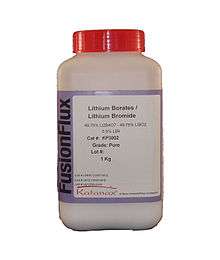Lithium metaborate
Lithium metaborate (LiBO2) is a chemical compound.
| Names | |
|---|---|
| Other names
boric acid, lithium salt | |
| Identifiers | |
3D model (JSmol) |
|
| ChemSpider | |
| ECHA InfoCard | 100.033.287 |
| EC Number |
|
PubChem CID |
|
CompTox Dashboard (EPA) |
|
| |
| |
| Properties | |
| LiBO2 | |
| Molar mass | 49.751 g/mol |
| Appearance | white hygroscopic monoclinic crystals |
| Density | 2.223 g/cm3 |
| Melting point | 849 °C (1,560 °F; 1,122 K) |
| 0.89 g/100 mL (0 °C) 2.57 g/100 mL (20 °C) 11.8 g/100 mL (80 °C) | |
| Solubility | soluble in ethanol |
| Thermochemistry | |
Heat capacity (C) |
59.8 J/mol K |
Std molar entropy (S |
51.3 J/mol K |
Std enthalpy of formation (ΔfH⦵298) |
-1022 kJ/mol |
Std enthalpy of combustion (ΔcH⦵298) |
33.9 kJ/mol |
| Hazards | |
| Safety data sheet | External MSDS |
| NFPA 704 (fire diamond) | |
Except where otherwise noted, data are given for materials in their standard state (at 25 °C [77 °F], 100 kPa). | |
| Infobox references | |
Applications
Lithium metaborate or lithium tetraborate (Li2B4O7), or a mixture of both, can be used in borate fusion sample preparation of various samples for analysis by XRF, AAS, ICP-OES, ICP-AES and ICP-MS.

Simultaneous determination of parts-per-million level Cr, As, Cd and Pb, and major elements in low level contaminated soils using borate fusion and energy dispersive X-ray fluorescence spectrometry with polarized excitation.[2]
Lithium metaborate dissolves acidic oxides such as SiO2 and Fe2O3, where the stoichiometric ratio of oxygen to cation, y/x in MxOy, is greater than unity. Lithium tetraborate dissolves basic oxides such as CaO, MgO and other oxides of the alkali metals and alkaline earth metals, where y/x ≤ 1. Most oxides are best dissolved in a mixture of the two lithium borate salts, for spectrochemical analysis.[3]
References
